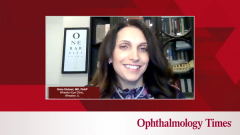
Experience with Soft Contact Lenses for Pediatric Myopia
Dr Noha Ekdawi shares her experience using soft contact lenses to combat myopia progression and emphasizes the importance of proactive treatment in managing myopia effectively.
Noha Ekdawi, MD, FAAP: More specifically about MiSight, my experience has been relatively positive. I do have a couple, more than a couple patients on MiSight contacts. I’ve had a few go get MiSight contacts and come back with multifocals. That’s been very confusing. I think sometimes they don’t tolerate it, or they’re told, if you get a multifocal, it is much cheaper. I’m not sure what happens in those conversations. I don’t tend to fit the MiSight contacts in my busy clinic anymore, so I have to send them to an outside optometrist or someone within my clinic that does MiSight contacts. But those who do have them find them most of the time comfortable. The vision is sometimes slightly degraded. I’m not going to say they all have 20/25 vision, but quite a few do, but they’re not bothered at school and they can read well. Those are 2 very important things if you’re going to put a kid in MiSight. Most parents have had a very positive experience, and that’s what they share with me and so do the kids.
One or two of the drawbacks is how many hours the kid has to wear it. Believe it or not, where most kids over wear their contacts, for some reason, I’ve had a few kids with MiSight contacts not wear them long enough. We know how many hours a day we need to wear those contacts, and some of them just don’t wear them every day or don’t wear them long enough in a day. I’m hesitant due to history of just seeing so many kids with contact lens irritation or keratitis. I don’t force a kid to wear them all day if they’re not, especially if they’re not progressing and we’re doing low-dose atropine and we’re doing outside time, of course.
In terms of cost of the MiSight, I hinted at this before. We discussed the value and the FDA approval of MiSight contacts. Some parents are very much in agreement right away. They want to do everything possible. They’re here for everything possible and that’s what they want to do right away. Some parents, they want to see progression or they want to try one thing at a time. I have some parents go, well, for this year, I’m going to do outside time. Then if they progress, then this year I’m going to do low-dose atropine. For me, the cost and value just depend so much on parents. The parents really drive whether the child ends up in MiSight contacts in my clinic or not. It’s those who are really gung-ho about everything or they’ve seen progression even on their treatment like my second case, then they very much are interested in MiSight contacts.
The most important thing for me about myopia and myopia control is where this is going. I think combined therapies is where we’re heading. I know I do my 3-prong approach of myopia progression cessation. I tell parents it’s not going to go to zero cessation, meaning no more progression. It might progress a little bit more with time, but the idea is to decrease progression, and maybe, and this is the most important part, prevent future issues. We know that with high myopia over -6, this is where we really see an increase in glaucoma, cataract, retinal tears and detachment, and macular issues. This is what we’re really trying to prevent. The joke is we’re making everybody a LASIK candidate, but that’s not actually our goal. Our goal is to decrease progression of myopia. Hopefully we hold the axial length and we hold the opportunities for adverse effects from high myopia in the future.
As a pediatric ophthalmologist, I’ve seen one too many kids with retinal detachments with high minus, and they go from retinal tears to flap retinal detachment, overlying the macula in a 9-year-old. I’ve seen the whole gamut of it, and that’s my real understanding of myopia, and that’s why I try to treat it so aggressively.
Transcript is AI generated and edited for clarity and readability.
Newsletter
Don’t miss out—get Ophthalmology Times updates on the latest clinical advancements and expert interviews, straight to your inbox.













































